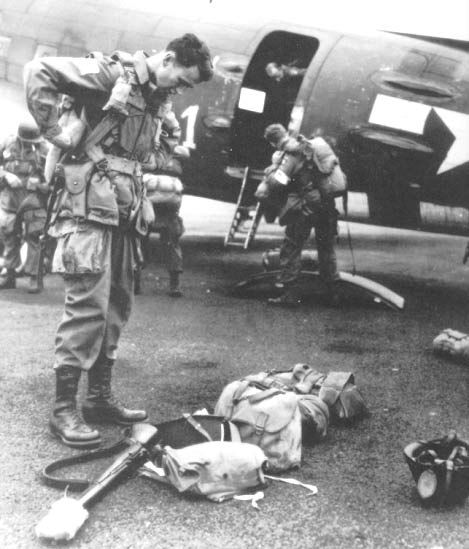
Major General James M. Gavin gearing up 5th June, 1944.
There were a number of possibilities considered, including the extremes of an airborne assault on Paris (which would be held until a link up with the sea-borne invasion force) and dropping the troops directly on the coastal defences at the beaches. More sanguine heads prevailed and eventually it was decided that the first Allied soldiers on French soil were indeed to be paratroops dropping ahead of the sea-borne landing. They would, however, drop inland to serve as a blocking force preventing reinforcements reaching the invasion beaches, and simultaneously seizing vital roads and bridges that would enable a breakout from the beachhead in due course. As ever they would also create as much confusion and havoc as possible in the enemy rear.
The US airborne troops were to arrive in Normandy in three different ways. Some 18,000 men from the 82nd and 101st would drop by parachute. Close behind them would be the gliders, and finally a small contingent (principally artillery) would come in across Utah Beach.
The final plan-its last revision made only a few days before the invasion called for the 82nd to drop on both sides of the Merderet River in order to secure Neuville-au-Plain, Ste-Mere-Eglise, Chef-du-Pont, Etienville, Amfreville and their surrounding areas. They were also to destroy bridges across the Douve River denying German reinforcements that route to the beaches.
To provide some measure of mutual support should things go badly on the beaches, the 101st’s DZs were close to those of the 82nd. Some re-assignment of objectives saw the 82nd draw Ste-Mere-Eglise originally slated for the 101st. This irony was reversed a few months later when the 101st got the toughest assignment at Bastogne by equal happenstance.
The gliders were to undertake the first operational night landing ever attempted, hopefully with the aid of beacons set up by pathfinders dropped ahead of them. There were not going to be enough gliders or pilots so some of the glider infantry and artillery were going to have to be part of the amphibious landing and link up with the rest of the division as soon as possible.
Originally D-Day was to be 5 June, but bad weather forced a postponement. Troopers by this time were already at the airfields and ports. The 456th PFA for instance had boarded ship at Rothgate dock in Cardiff on 3 June, its vehicles and guns having been loaded over the previous few days. Airfields all over southern England were lined with aircraft bearing the hastily applied black and white ‘invasion stripes’ mandated for the day. (Aircraft recognition was poor throughout armies in 1944, and the Allies wanted no repeat of the Sicily debacle.)
At 17.15hrs on the 5th the 456th was amongst a growing armada that set sail for France, at about the same time as the paratroopers were checking their equipment and weapons. They expected to be on their own for a while before the ‘legs’ got off the beaches and were consequently heavily armed in addition to their bulky T5 parachutes and reserves. Troopers carried as much ammunition, grenades and fighting knives as could physically be managed. Most men hefted nearly 100 pounds of equipment-making the mandatory yellow ‘Mae West’ life preserver a somewhat doubtful assistance in the event of a water landing. Surprisingly few accidents were reported in the circumstances, although the 505th suffered three killed and ten wounded when a grenade exploded as its men were boarding their aircraft.
At around 23.00hrs the first pathfinders took off, and a little over an hour later over 1,000 C-47s were following them. The greatest invasion in history was under way. Some 378 of these aircraft carried the 82nd’s three regiments with 52 gliders accompanying them with anti-tank guns and other heavy equipment.
The assault force was to fly what today would be called a ‘Io-hi-Io’ profile. Crossing the English Channel at 500 feet or less to avoid radar, they would climb to 1,500 feet while crossing the coast in an attempt to escape German small-arms fire and light flak, before dropping once again to 500 feet as they approached the drop zones.